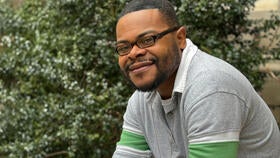
When staff, faculty, and students join Yale, the Microsoft or Google email account they receive is the result of software created by Howard Gilbert, software engineer, whose 50 years at Yale span from the time the information technology (IT) department had a sole IBM mainframe computer to its present network of tens of thousands of computers. Gilbert is further notable for being a member of the team that developed the original design of Yale’s CAS system and then maintained and adapted it for decades. Today, he continues to engineer university IT systems—all in a day’s work for someone who “finds it very enjoyable” to solve problems following laser-focused research and clear-cut methodology.
"Howard has a deep passion for the Identity and Access Management space, and his meticulous attention to detail has kept some of Yale’s most critical systems running for decades,” said Brad Hajzak, IT Director. “He’s always been effective at keeping up with the shifts and new technologies in the landscape.”
Yale graduate, then staff member
Gilbert was fresh out of Trinity College in Hartford with a degree in mathematics when he arrived at Yale to attend graduate school. Born and raised in Detroit, he decided to stay in New England to follow a new-found interest in statistics. The study of statistics led Gilbert to work with early computers in the Yale Computer Center in the 1970s. He became fascinated enough with them to choose IT as a profession. Gilbert moved from student to staff member when he was hired in what was then called User Services and is today the Help Desk—but back then the whole desk was a group of four.
Gilbert’s next career home was the IT systems group, which was responsible for configuring and running the large IBM mainframe. “We had so few people,” he recalled, “that I did everything from placing power cables under the floor to taking the computer down, to rebooting it, backing it up, and modifying software to do the accounting function.”
Campus computers were not the most powerful of those available at the time, but Yale software engineers did develop software and work with software used by universities around the world. One pre-Internet project that Gilbert worked on was a collaboration between Yale and the City University of New York to adapt IBM software—used mainly to build large internal corporate networks—to connect universities to each other. The link between these two universities became “Bitnet,” which was, before the Internet, a way for all students and faculty at 500 international educational institutions or university systems worldwide to send mail and files to each other. Yale-coded software bridged this and other gaps between the special communication needs of universities and the mainstream computer networks that were designed to support business problems.
“When I first came to Yale in the early 90’s,” said William Welch, IT software engineer, “Howard and team were the ones that we all looked up to, to find solutions for the new world of computing that we were in. He is so good at what he does, excellent at building code, and he comes up with wonderful solutions supported by rock-solid documentation.”
IT’s Andrew Newman, recent retiree, and a long-time colleague of Gilbert, likes to say that his Yale career was “enhanced immeasurably” by knowing and working with Gilbert. “He has dedicated his time here because he saw the opportunity to serve the university and to provide solutions through technology that would make the place better,” said Newman.
President Salovey and senior leaders recognized Gilberts’ 50 years of service at the Long-Service Recognition Dinner held in May. Gilbert is one of 331 staff members who marked milestone anniversaries this year.
Star solutionist
Gilbert notes that the whole trajectory of his career has followed that of technology itself. Technology has changed so rapidly that his 50-year career is largely marked by transition: “You see a cycle happen over and over, a decade for something to grow, and then a decade for it to be replaced by something else. And after a while, you realize the cycle is permanent. Even so, you take pride in what you build today without the expectation of how long it will last.”
Pride in his work stands out to colleagues who praise Gilbert for the generosity with which he shares his knowledge and thought processes on a project. The word “solutionist” seems to describe what he acknowledges himself—his love of solving problems.
“If you give me a computer problem, there's a set of rules represented by the background information, and I can diagnose the problem. I can learn more than I knew about a subject, and I can figure out what the issue is,” said Gilbert. “And there comes that Eureka moment: I figured out how to do it or I figured out what is wrong. I solve the problem. I document the results. I deliver your program. And then I'm looking for the next problem. It's this pursuit of the solution that keeps me interested and active and involved. It’s what I call fun.”






